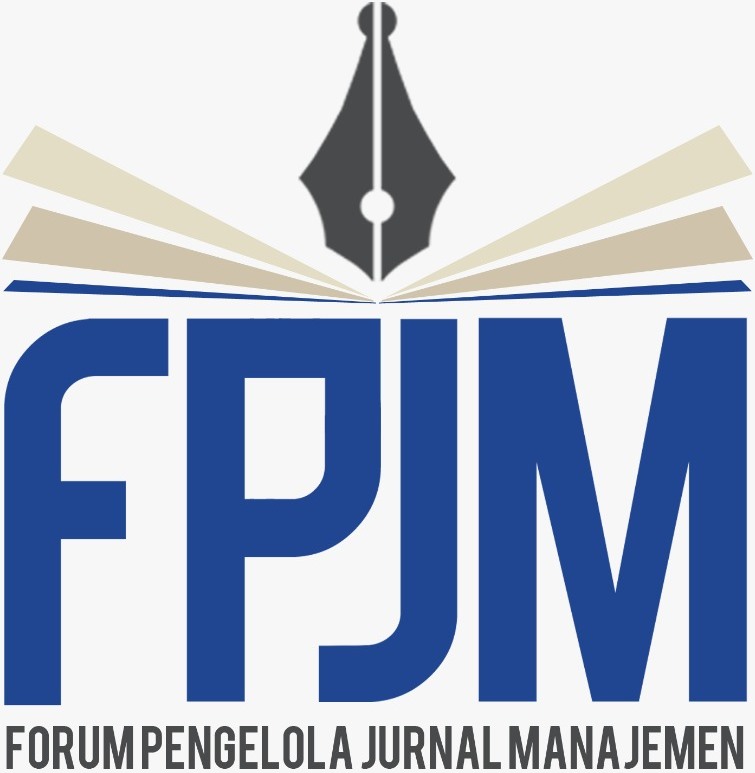PARTNERSHIP-BASED BUSINESS RESILIENCE MODEL FOR VILLAGE-OWNED ENTERPRISES (BUMDES)
Abstract
ABSTRACT
This study analyzes the optimal institutional model for supporting BUMDes business development in several sectors. This study uses the Multiple-Criteria Decision-Making (MCDM) approach with Interpretative Structural Modeling (ISM) as an analysis tool. Data was collected through interviews and focus group discussions with experts and stakeholders involved in BUMDes development. The study results indicate that the Village Government and Supervisors are the main driving factors in forming the BUMDes business ecosystem. BUMDes is the leading implementer of village businesses and is supported by various stakeholders. This partnership-based business resilience model emphasizes synchronization between the Village Head and BUMDes and the independence of BUMDes within the appropriate regulatory framework. Managerial implications include increasing BUMDe's professionalism, independence, strategic partnerships, and long-term planning. This study contributes to the BUMDes development literature by offering a holistic approach to analyzing the optimal institutional model in supporting BUMDes business growth.
ABSTRAK
Penelitian ini bertujuan untuk menganalisis model kelembagaan yang optimal dalam mendukung pengembangan bisnis BUMDes di beberapa sektor. Penelitian ini menggunakan pendekatan Multiple-Criteria Decision-Making (MCDM) dengan Interpretative Structural Modeling (ISM) sebagai alat analisis. Pengumpulan data dilakukan melalui wawancara dan focus group discussion dengan para ahli dan stakeholder yang terlibat dalam pengembangan BUMDes. Hasil penelitian menunjukkan bahwa Pemerintah Desa dan Pengawas merupakan faktor pendorong utama dalam membentuk ekosistem bisnis BUMDes. BUMDes berperan sebagai pelaksana utama usaha desa, didukung oleh berbagai pemangku kepentingan. Model ketahanan bisnis berbasis kemitraan ini menekankan sinkronisasi antara Kepala Desa dan BUMDes, serta kemandirian BUMDes dalam kerangka regulasi yang tepat. Implikasi manajerial meliputi peningkatan profesionalisme BUMDes, kemandirian, kemitraan strategis, dan perencanaan jangka panjang. Penelitian ini berkontribusi pada literatur pengembangan BUMDes dengan menawarkan pendekatan holistik untuk menganalisis model kelembagaan yang optimal dalam mendukung pertumbuhan bisnis BUMDes.
Keywords
References
Anggraeni, M. R. R. S. (2016). Peranan Badan Usaha Milik Desa (BUMDes) pada kesejahteraan masyarakat pedesaan studi pada BUMDes di Gunung Kidul, Yogyakarta [The role of Village-Owned Enterprises (BUMDes) in rural community welfare: A study of BUMDes in Gunung Kidul, Yogyakarta]. Modus, 28(2), 155-167.
Baldacci, E., Clements, B., Gupta, S., & Cui, Q. (2008). Social spending, human capital, and growth in developing countries. World Development, 36(8), 1317-1341. https://doi.org/10.1016/j.worlddev.2007.08.003
Banerjee, A. V., & Duflo, E. (2007). The economic lives of the poor. Journal of Economic Perspectives, 21(1), 141-168. https://doi.org/10.1257/jep.21.1.141
BPS Kabupaten Bogor. (2023). Produk Domestik Regional Bruto Kabupaten Bogor Menurut Lapangan Usaha 2018-2022 [Gross Regional Domestic Product of Bogor Regency by Industry 2018-2022]. BPS Kabupaten Bogor.
BPS Kecamatan Bojong Gede. (2023). Kecamatan Bojong Gede Dalam Angka 2023 [Bojong Gede Subdistrict in Figures 2023]. BPS Kabupaten Bogor.
Dye, T. R. (1978). Understanding public policy (3rd ed.). Prentice Hall.
Edward III, G. C. (1980). Implementing public policy. Congressional Quarterly Press.
Eko, S., Khasanah, T. I., Widuri, D., Handayani, S., Handayani, N., & Qomariyah, P. (2014, February). Desa membangun indonesia [Villages developing Indonesia]. In Forum Pengembangan Pembaharuan Desa (FPPD).
Eriyatno. (2003). Ilmu Sistem: Meningkatkan Mutu dan Efektivitas Manajemen [Systems Science: Improving Management Quality and Effectiveness]. IPB Press.
Fan, S., Yu, B., & Saurkar, A. (2008). Public spending in developing countries: Trends, determination, and impact. In S. Fan (Ed.), Public expenditures, growth, and poverty (pp. 20-55). Johns Hopkins University Press.
He, L. (2020). Measuring the effects of globalisation on economic growth, energy consumption, and CO2 emissions: Evidence from G20 countries. International Journal of Sustainable Development & World Ecology, 27(6), 523-536. https://doi.org/10.1080/13504509.2020.1784582
Hogwood, B. W., & Gunn, L. A. (1986). Policy analysis for the real world. Oxford University Press.
Inapty, B. A., Sururi, A., Hermana, D., & Abidin, A. Z. (2021). Management strategy of village-owned enterprises (BUMDes) in the empowerment of village community-based tourism. Jurnal Manajemen dan Kewirausahaan, 23(2), 108-123. https://doi.org/10.9744/jmk.23.2.108-123
Mustanir, A. (2016). Implementasi Kebijakan Dana Desa Dan Partisipasi Masyarakat Dalam Pembangunan Di Desa Teteaji Kecamatan Tellu Limpoe Kabupaten Sidenreng Rappang [Implementation of Village Fund Policy and Community Participation in Development in Teteaji Village, Tellu Limpoe Subdistrict, Sidenreng Rappang Regency]. Jurnal Politik Profetik, 4(2).
Nasution, L. N. H., Dharmawan, A. H., & Sumarti, T. (2017). Pertambangan Emas di Wilayah Maluku Barat Daya: Kutukan atau Berkah? (Studi Kasus Konflik Akses Sumber Agraria) [Gold Mining in Southwest Maluku: A Curse or a Blessing? (Case Study of Agrarian Resource Access Conflict)]. Sodality: Jurnal Sosiologi Pedesaan, 5(2), 163–170. https://doi.org/10.22500/sodality.v5i2.17978
Ridlwan, Z. (2014). Urgensi Badan Usaha Milik Desa (BUMDes) dalam pembangun perekonomian desa [The urgency of Village-Owned Enterprises (BUMDes) in village economic development]. Fiat Justisia: Jurnal Ilmu Hukum, 8(3), 424-440. https://doi.org/10.25041/fiatjustisia.v8no3.314
Saxena, J. P. (1992). Hierarchy and classification of program plan elements using interpretive structural modeling. Systems Practice, 5(6), 651-670. https://doi.org/10.1007/BF01083616
Soejono, F., Supriyono, B., & Mardiyono, M. (2021). Performance of village-owned enterprises: Influencing factors and impacts on rural development in Indonesia. International Research Journal of Business Studies, 14(2), 155-174. https://doi.org/10.21632/irjbs.14.2.155-174
Spalding, N. J. (1990). The sustainability of the process of urbanization in developing countries. International Journal of Environmental Studies, 36(1-2), 137-144. https://doi.org/10.1080/00207239008710583
Suhendi, & Hamzah. (2024). Sustainability Strategy of Bumdes Based on Business Priority Setting The Topsis Method. Business Review and Case Studies, 5(2), 330. https://doi.org/10.17358/brcs.5.2.330
Tamboto, H. J., & Manongko, A. A. C. (2019). Model Pengentasan Kemiskinan Masyarakat Pesisir Berbasis Literasi Ekonomi dan Modal Sosial [Coastal Community Poverty Alleviation Model Based on Economic Literacy and Social Capital]. Jurnal Ekonomi Pembangunan, 17(2), 75-88. https://doi.org/10.29259/jep.v17i2.8966
Wijaya, F. (2023). The contributions, challenges, and role of village-owned enterprises in rural development: A case study of Indonesia. Journal of Rural Studies, 97, 71-82. https://doi.org/10.1016/j.jrurstud.2022.12.007
Winarti, A., & Purwanti, E. Y. (2014). Analisis pengaruh pengeluaran pemerintah bidang pendidikan, kemiskinan, dan PDB terhadap indeks pembangunan manusia di Indonesia periode 1992-2012 [Analysis of the influence of government spending on education, poverty, and GDP on the human development index in Indonesia for the period 1992-2012]. Diponegoro Journal of Economics, 3(1), 1-10.
World Bank. (2000). World development report 2000/2001: Attacking poverty. World Bank. https://doi.org/10.1596/0-1952-1129-4
DOI: 10.34203/jimfe.v11i1.10866
Refbacks
- There are currently no refbacks.
Copyright (c) 2025 The Author(s)

This work is licensed under a Creative Commons Attribution-NonCommercial-ShareAlike 4.0 International License.











